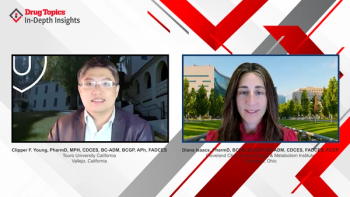Examining the Clinical Impact of Hypercortisolism in Patients

EP. 1: Examining the Differential Diagnosis of Hypercortisolism
ByDiana Isaacs, PharmD, BCPS, BCACP, BC-ADM, CDCES, FADCES, FCCP,Clipper F. Young, PharmD, MPH, CDCES, BC-ADM, BCGP, APh, FADCES Panelists discuss how hypercortisolism represents a spectrum from overt Cushing syndrome to hidden forms that lack classic physical signs, with causes including exogenous corticosteroid use, endogenous overproduction from pituitary adenomas or adrenal sources, ectopic tumors, and pseudo Cushing syndrome, emphasizing that early detection is crucial because chronic cortisol elevation can lead to severe complications including resistant diabetes, hypertension, cardiovascular disease, osteoporosis, and psychiatric conditions that significantly impact morbidity and mortality if left untreated.

EP. 2: Exploring Reasons for the Underdiagnosis of Hypercortisolism
ByDiana Isaacs, PharmD, BCPS, BCACP, BC-ADM, CDCES, FADCES, FCCP,Clipper F. Young, PharmD, MPH, CDCES, BC-ADM, BCGP, APh, FADCES Panelists discuss how hypercortisolism presents with both overt symptoms like central obesity, muscle wasting, easy bruising, purple striae, moon face, and buffalo hump, as well as nonspecific features including weight gain, resistant hyperglycemia, severe hypertension, dyslipidemia, osteoporosis, and psychiatric disorders, explaining that these overlapping symptoms with common chronic diseases like diabetes and hypertension often mask the underlying condition, leading to underdiagnosis as clinicians focus on adding more medications rather than investigating potential underlying causes, while the disease's perceived rarity in medical education further contributes to missed diagnoses despite hypercortisolism being more prevalent than previously thought.

EP. 3: Selecting the Appropriate Screening Test
ByDiana Isaacs, PharmD, BCPS, BCACP, BC-ADM, CDCES, FADCES, FCCP,Clipper F. Young, PharmD, MPH, CDCES, BC-ADM, BCGP, APh, FADCES Panelists discuss how the most appropriate initial screening test for hypercortisolism is the 1 mg overnight dexamethasone suppression test, which is considered the most sensitive first-line diagnostic tool, followed by 24-hour urinary free cortisol and late-night salivary cortisol measurements, with patient-specific factors including the need to measure dexamethasone levels to exclude false positives (especially important in diabetes patients where false positive rates can reach 20%), and how subsequent ACTH levels and imaging studies help differentiate between ACTH-dependent causes (like pituitary adenomas or ectopic tumors) and ACTH-independent causes (autonomous adrenal overproduction), while dehydroepiandrosterone sulfate levels provide additional diagnostic value by helping distinguish between these different etiologies in conjunction with ACTH measurements.

EP. 4: The Impact on Quality of Life and Relevant Clinical Studies
ByDiana Isaacs, PharmD, BCPS, BCACP, BC-ADM, CDCES, FADCES, FCCP,Clipper F. Young, PharmD, MPH, CDCES, BC-ADM, BCGP, APh, FADCES Panelists discuss how untreated hypercortisolism has significant detrimental effects on quality of life through metabolic complications like resistant hypertension and dyslipidemia that increase cardiovascular mortality risk, physical manifestations including weight gain, muscle wasting, skin changes, and early osteoporosis, neurological issues such as brain fog and mood disorders, and immunosuppression leading to increased infection risk, while highlighting the groundbreaking CATALYST study findings that revealed hypercortisolism prevalence of 23.8% in patients with difficult-to-control type 2 diabetes (with even higher rates of 33.3% in those with cardiac disorders and 36.6% in those taking multiple antihypertensive medications), demonstrating that this condition is far more common than previously believed and should prompt increased screening in clinical practice.

EP. 5: The Role of the Pharmacist in Screening
ByDiana Isaacs, PharmD, BCPS, BCACP, BC-ADM, CDCES, FADCES, FCCP,Clipper F. Young, PharmD, MPH, CDCES, BC-ADM, BCGP, APh, FADCES Panelists discuss how pharmacists play a crucial role in identifying patients with suspected hypercortisolism by recognizing treatment resistance patterns when reviewing medication lists, particularly noting red flags like patients on multiple diabetes medications (including maximized GLP-1 agonists, SGLT-2 inhibitors, and high-dose insulin) or multiple antihypertensive agents who still have uncontrolled hemoglobin A1c levels above 7.5%, while addressing barriers such as nonspecific symptoms that lack classic physical features, logistical challenges around diagnostic authority and the need for collaborative practice agreements, systemic gaps including lack of consistent screening guidelines, and the importance of increasing clinical suspicion, strategic use of the one milligram overnight dexamethasone suppression test with proper patient coordination and education, and establishing interprofessional collaboration for referrals to endocrinologists when hypercortisolism is identified.

EP. 6: Optimizing Multidisciplinary Care
ByDiana Isaacs, PharmD, BCPS, BCACP, BC-ADM, CDCES, FADCES, FCCP,Clipper F. Young, PharmD, MPH, CDCES, BC-ADM, BCGP, APh, FADCES Panelists discuss how pharmacists can optimize multidisciplinary care for hypercortisolism by leveraging their training in chronic disease management and collaborative practice agreements to flag patients with persistent uncontrolled diabetes for screening, coordinate the diagnostic process and referrals to endocrinologists, and manage diabetes and hypertension while incorporating diabetes technology into treatment plans, and potentially oversee the use of newly approved medications like mifepristone for hypercortisolism treatment with appropriate monitoring for adverse effects like hypokalemia, while also exploring innovative solutions such as virtual care consultations, artificial intelligence–assisted imaging interpretation, and deprescribing of diabetes and blood pressure medications when hypercortisolism treatment successfully reduces cortisol levels.


